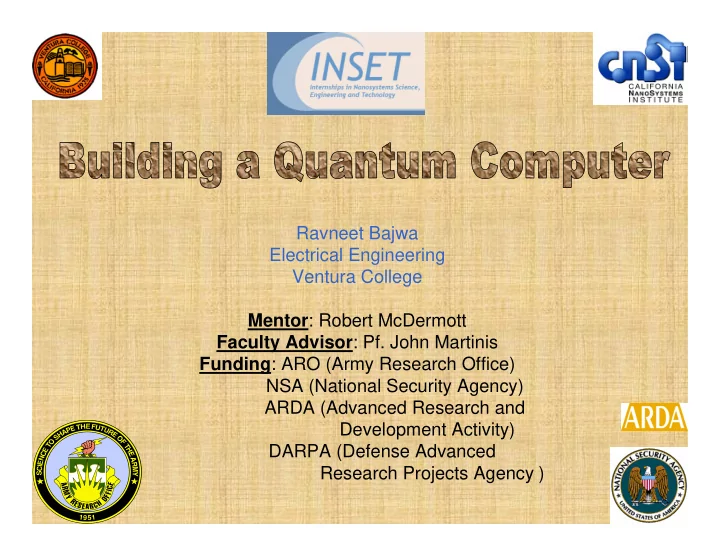

Ravneet Bajwa Electrical Engineering Ventura College Mentor : Robert McDermott Faculty Advisor : Pf. John Martinis Funding : ARO (Army Research Office) NSA (National Security Agency) ARDA (Advanced Research and Development Activity) DARPA (Defense Advanced Research Projects Agency )
Motivation � Ever-increasing need for fast computers Difference Between Quantum and Classical computation � Number of informational states in a quantum and classical bit � 2-bit classical 2-qubits (2 x 1 possible states) (2 x 2 possible states) � A 32-bit quantum processor could be as powerful as 4 billion Pentium 4’s Applications: � Powerful decryption tool and could break even most secured encryption used today � Search engines much faster than Google by using fewer computers � Could solve many complex problems in a reasonable amount of time
Technique: Use of superconducting Josephson junction to build a quantum bit (Qubit) 130 nm 2 nm Martinis group UCSB
Dilution Refrigerator: � Phase separation of 3 He and 4 He Mixture below 1 K. University of Washington � 3 He is pumped out from the 4 He rich phase � For equilibrium some 3 He has to move across the phase boundary � 3 He is pumped back and constantly circulated
Plan: � Build an artificial atom � Use lowest two energy states to represent binary numbers: 0 and 1 � Use microwave pulses to switch between energy states Obstacles: � Phase De-coherence due to critical current or magnetic flux noise
Critical Current noise or Magnetic flux noise? � Resonant frequency depends on the amount of magnetic flux through the qubit Case 2 Case 1 � Operation of the qubit close to the resonant frequency at opposite flux bias � Different behavior of the noises towards magnetic flux bias Courtesy of Martinis group UCSB
Future Modifications � Making wires as thin as possible � Better materials for the junction to increase the coherence time Courtesy of Martinis group UCSB
Acknowledgements � Faculty Advisor: Pf. John Martinis � Mentor: Robert McDermott � Group Members: Markus Ansmann, Matthias Steffen, Matthew Neley, Hunter McDaniel, Darren Powell � People who made it Possible: Trevor Hirst, Nicholas Arnold, Liu-Yen Kramer and Michael Northen
What did I learn? � How a formal research works? � Got introduced to cryogenic electronics and materials � Got my hands on important electronic equipment and got exposed to formal data keeping � Learnt basics of quantum computing � Learnt to design and make printed circuit boards � Learnt computer programs such as lab view which are used for data acquisition � Learnt how important undergraduate research is.
Recommend
More recommend